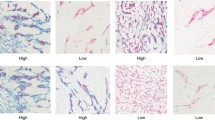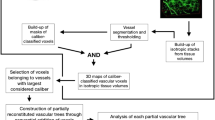Abstract
To analyze the presence of mature and immature vessels as a prognostic factor in patients with renal cell carcinoma and propose a classification of renal cancer tumor blood vessels according to morphometric parameters. Tissue samples were obtained from 121 renal cell carcinoma patients who underwent radical nephrectomy. Staining with CD31 and CD34 was used to differentiate between immature (CD31+) and mature (CD34+) blood vessels. We quantified the microvascular density, microvascular area and different morphometric parameters: maximum diameter, minimum diameter, major axis, minor axis, perimeter, radius ratio and roundness. We found that the microvascular density was higher in CD31+ than CD34+ vessels, but CD34+ vessels were larger than CD31+ vessels, as well as being strongly correlated with the ISUP tumor grade. We also identified four vascular patterns: pseudoacinar, fascicular, reticular and diffuse. Pseudoacinar and fascicular patterns were more frequent in clear cell renal cell carcinoma (37.62 and 35.64% respectively), followed by reticular pattern (21.78%), while in chromophobe tumors the reticular pattern predominated (90%). The isolated pattern was present in all papillary tumors (100%). In healthy renal tissue, the pseudoacinar and isolated patterns were differentially found in the renal cortex and medulla respectively. We defined four distinct vascular patterns significantly related with the ISUP tumor grade in renal cell carcinomas. Further studies in larger series are needed in order to validate these results. Analysis of both mature and immature vessels (CD34+ and CD31+) provides additional information when evaluating microvascular density.



Similar content being viewed by others
References
Zhang B, Ji H, Yan D, Liu S, Shi B (2014) Lack of association of microvessel density with prognosis of renal cell carcinoma: evidence from meta-analysis. Tumor Biol 35(3):2769–2776
Döme B, Hendrix MJC, Paku S, Tóvári J, Tímár J (2007) Alternative vascularization mechanisms in cancer. Am J Pathol 170(1):1–15
Srigley JR, Delahunt B (2009) Uncommon and recently described renal carcinomas. Mod Pathol 22(Suppl 2):S2–23
Murphy WM, Grignon DG, Perlman EJ (2004) Tumors of the kidney, bladder, and related urinary structures. American Registry of Pathology, Washington
Delahunt B, Eble JN, McCredie MR, Bethwaite PB, Stewart JH, Bilous AM (2001) Morphologic typing of papillary renal cell carcinoma: comparison of growth kinetics and patient survival in 66 cases. Hum Pathol 32:590–595
Storkel S, Eble JN, Adlakha K et al (1997) Classification of renal carcinoma. Cancer 80:987–989
Thoenes W, Storkel S, Rompelt HJ, Moll R, Baum HP, Werner S (1988) Chromophobe cell renal carcinoma and its variants. A report in 32 cases. J. Pathol 155:277–287
Hlatky L, Hahnfeldt P, Folkman J (2002) Clinical application of antiangiogenic therapy: microvessel density, what it does and doesn’t tell us. J Nat Cancer Inst 94:883–893
Grizzi F, Colombo P, Barbieri B et al (2001) Microscopic analysis and significance of vascular architectural complexity in renal cell carcinoma. Clin Cancer Res 7:3305–3307
Weidner N, Semple JP, Welch WR, Folkman J (1991) Tumor angiogenesis and metastasis: correlation in invasive breast carcinoma. N Engl J Med 324:1–8
Grizzi F, Ceva-Grimaldi G, Dioguardi N (2001a) Fractal geometry: a useful tool for quantifying irregular lesions in human liver biopsy specimens. Ital J Anat Embryol 106:337–346
Kovacs G, Akhtar M, Beckwith BJ et al (1997) The Heidelberg classification of renal cell tumours. J Pathol 80:992–993
Ljungberg B, Bensalah K, Canfield S, Dabestani S, Hofmann F, Hora M, et al (20015). EAU Guidelines on Renal Cell Carcinoma 2014 Update. Eur Urol 67(5): 913–924
Delahunt B, Srigley JR, Montironi R, Egevad L (2014) Advances in renal neoplasia: recommendations from the 2012 International Society of Urological Pathology Consensus Conference. Urology 83(5):969–974
Poblet E, González-Palacios F, Jimenez FJ (1996) Different immunoreactivity of endotelial markers in well and poorly differentiated areas of angiosarcomas. Virchows Arch 428:217–221
Yilmazer D, Han U, Onal B (2007) A comparison of the vascular density of VEGF expression with microvascular density determined with CD34 and CD31 staining and conventional prognostic markers in renal cell carcinoma. Int Urol Nephrol 39:691–698
Meert AP, Paesmans M, Martin B, Delmotte P, Berghmans T, Verdebout JM, Lafitte JJ, Mascaux C, Sculier JP (2002) The role of microvessel density on the survival of patients with lung cancer: a systematic review of the literature with meta-analysis. Br J Cancer 87:694–701
Uzzan B, Nicolas P, Cucherat M, Perret GY (2004) Microvessel density as a prognostic factor in women with breast cancer: a systematic review of the literature and meta-analysis. Cancer Res 64:2941–2955
Des Guetz G, Uzzan B, Nicolas P, Cucherat M, Morere JF, Benamouzig R, Breau JL, Perret GY (2006) Microvessel density and VEGF expression are prognostic factors in colorectal cancer. Meta-analysis of the literature. Br J Cancer 94:1823–1832
Ruiz-Saurí A, Valencia-Villa G, Romanenko A, Pérez J, García R, García H, Benavent J, Sancho-Tello M, Carda C, Llombart-Bosch A (2016) Influence of exposure to chronic persistent low-dose ionizing radiation on the tumor biology of clear-cell renal-cell carcinoma. An Immunohistochemical and morphometric study of angiogenesis and vascular related factors. Pathol Oncol Res 22(4):807–815
Joo HJ, Oh DK, Kim YS, Lee KB, Kim SJ (2004) Increased expression of caveolin-1 and microvessel density correlates with metastasis and poor prognosis in clear cell renal cell carcinoma. BJU Int 93:291–296
Nativ O, Sabo E, Reiss A, Wald M, Madjar S, Moskovitz B (1998) Clinical significance of tumor angiogenesis in patients with localized renal cell carcinoma. Urology 51:693–696
Yoshino S, Kato M, Okada K (1995) Prognostic significance of microvessel count in low stage renal cell carcinoma. Int J Urol 2:156–160
MacLennan GT, Bostwick DG (1995) Microvessel density in renal cell carcinoma: lack of prognostic significance. Urology 46:27–30
Minardi D, Lucarini G, Mazzucchelli R, Milanese G, Natali D, Galosi AB, Montironi R, Biagini G, Muzzonigro G (2005) Prognostic role of Fuhrman grade and vascular endothelial growth factor in pT1a clear cell carcinoma in partial nephrectomy specimens. J Urol 174:1208–1212
Anastassiou G, Duensing S, Steinhoff G, Zorn U, Grosse J, Dallmann I, Kirchner H, Ganser A, Atzpodien J (1996) Platelet endothelial cell adhesion molecule-1 (PECAM-1): a potential prognostic marker involved in leukocyte infiltration of renal cell carcinoma. Oncology 53:127–132
Imao T, Egawa M, Takashima H, Koshida K, Namiki M (2004) Inverse correlation of microvessel density with metastasis and prognosis in renal cell carcinoma. Int J Urol 11:948–953
Rioux-Leclercq N, Epstein JI, Bansard JY, Turlin B, Patard JJ, Manunta A, Chan T, Ramee MP, Lobel B, Moulinoux JP (2001) Clinical significance of cell proliferation, microvessel density, and CD44 adhesion molecule expression in renal cell carcinoma. Hum Pathol 32:1209–1215
Sabo E, Boltenko A, Sova Y, Stein A, Kleinhaus S, Resnick MB (2001) Microscopic analysis and significance of vascular architectural complexity in renal cell carcinoma. Clin Cancer Res 7:533–537
Schraml P, Struckmann K, Hatz F, Sonnet S, Kully C, Gasser T, Sauter G, Mihatsch MJ, Moch H (2002) VHL mutations and their correlation with tumour cell proliferation, microvessel density, and patient prognosis in clear cell renal cell carcinoma. J Pathol 196:186–193
Cheng S-H, Liu J-M, Liu Q-Y, Luo D-Y, Liao B-.H, Li H, Wang K-J (2014). Prognostic role of microvessel density in patients with renal cell carcinoma: a meta-analysis. Int J Clin Exp Pathol 7(9): 5855–5863
Ferician O, Cimpean AM, Ceasu AM, Dema A, Raica M, Cumpanas A (2016) Heterogeneous vascular patterns in renal cell carcinomas. Pol J Pathol 67(1):46–53
Joshi S, Singh AR, Durden DL (2015) Pan-PI-3 kinase inhibitor SF 1126 shows antitumor and antiangiogenic activity in renal cell carcinoma. Cancer Chemother Pharmacol 75:595–608
Schirner M, Hoffmann J, Menrad A, Schneider MR (1998) Antiangiogenic chemotherapeutic agents: characterization in comparison to their tumor growth inhibition in human renal cell carcinoma models. Clin Cancer Res 4:1331–1336
Travnicek I, Branzovsky H, Kalusova K, Hess O, Holubec L, Pele KB, Ürge T, Hora M (2015) Tissue biomarkers in predicting response to sunitinib treatment of metastatic renal cell carcinoma. Anticancer Res 35:5661–5666
Porta C, Giglione P, Liguigli W, Paglino C (2015) Dovitinib (CHIR258, TKI258): structure, development and preclinical and clinical activity. Future Oncol 11:39–50
Okoń K, Kawa R (2008) Microvascular network in renal carcinomas. Quantitative and tissue microarray immunohistochemical study. Pol J Pathol 59:107–115
Tinini T, Rossi F, Claudio PP (2003) Molecular basis of angiogenesis and cancer. Oncogene 22:6549–6556
Eberhard A, Kahlert S, Goede V, Hemmerlein B, Plate KH, Augustin HG (2000) Heterogeneity of angiogenesis and blood vessel maturation in human tumors: implications for antiangiogenic tumor therapies. Cancer Res 60:1388–1393
Author information
Authors and Affiliations
Corresponding author
Ethics declarations
Conflict of Interest
We declare no conflict of interest.
Rights and permissions
About this article
Cite this article
Ruiz-Saurí, A., García-Bustos, V., Granero, E. et al. Distribution of Vascular Patterns in Different Subtypes of Renal Cell Carcinoma. A Morphometric Study in Two Distinct Types of Blood Vessels. Pathol. Oncol. Res. 24, 515–524 (2018). https://doi.org/10.1007/s12253-017-0262-y
Received:
Accepted:
Published:
Issue Date:
DOI: https://doi.org/10.1007/s12253-017-0262-y




